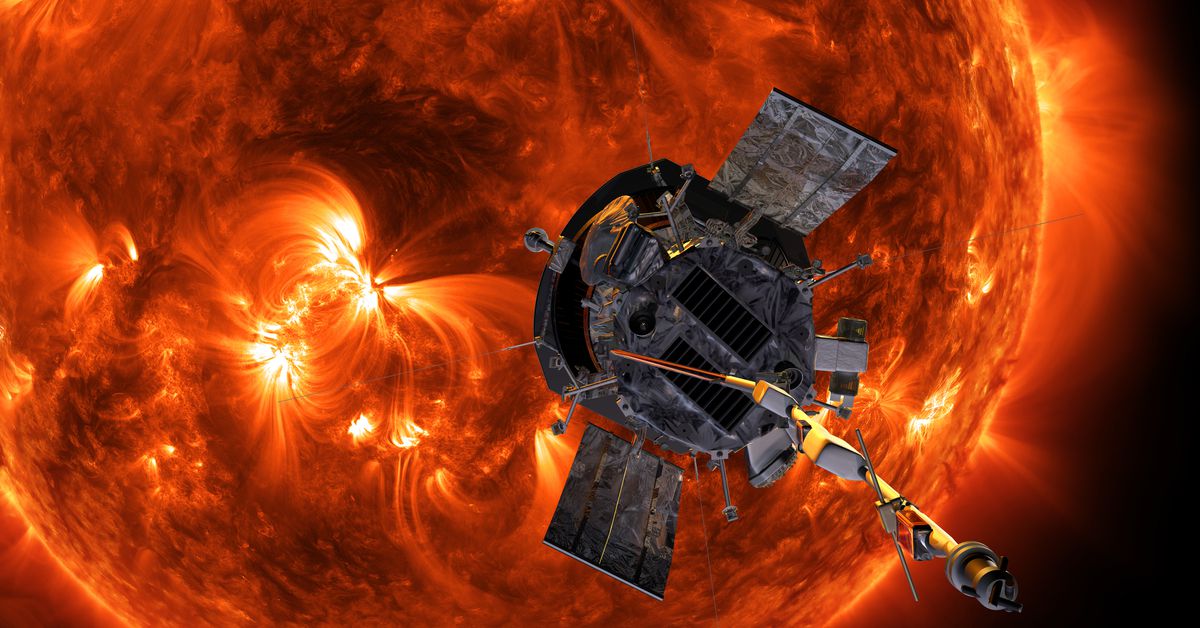A Historic Achievement in Space Exploration
On December 26th, NASA’s Parker Solar Probe made history by transmitting a signal back to Earth from an unprecedented distance of just 3.8 million miles from the surface of the Sun. This remarkable feat marks the closest any human-made object has ever gotten to the star at the center of our solar system. The probe’s successful close flyby is a testament to the ingenuity and perseverance of scientists and engineers who designed and launched this mission.
The Mission’s Objectives
The Parker Solar Probe was sent on its perilous journey on December 20th, with the primary objective of studying the Sun’s corona, also known as the outer atmosphere. By getting closer to the Sun than any previous spacecraft, the probe aims to gather detailed information about solar wind, the Sun’s heat, and how energetic particles are accelerated to near light speed.
A Record-Breaking Flyby
The closest approach occurred on December 24th, when the Parker Solar Probe flew past the solar surface at a staggering speed of 430,000 miles per hour. During this brief window, mission operations were out of contact with the probe, leaving scientists and engineers anxiously waiting for confirmation of its success.
Confirmation of Success
NASA has now confirmed that the Parker Solar Probe is in good health and operating normally, as indicated by the signal transmitted back to Earth on December 26th. This news comes as a relief to the team behind the mission, who had been worried about the probe’s survival during the intense heat and radiation encountered near the Sun.
What’s Next?
Now that NASA has confirmation of the mission’s success, the next step is for the Parker Solar Probe to send detailed telemetry data on its status. This information is expected to arrive on January 1st, providing scientists with valuable insights into the probe’s performance during the close flyby. The data will help researchers better understand the complex phenomena surrounding the Sun and improve our understanding of space weather.
The Technology Behind the Probe
To withstand the extreme conditions near the Sun, the Parker Solar Probe is equipped with a Sun-facing heat shield that can withstand temperatures of up to 2,500 degrees Fahrenheit (1,371°C). Meanwhile, the probe itself remains at a relatively cool temperature of around 85°F (29°C), thanks to its advanced thermal protection system.
The Significance of This Mission
This mission marks a significant milestone in space exploration and our understanding of the Sun. By studying the corona, scientists hope to gain insights into the underlying mechanisms that drive solar wind and energetic particle acceleration. The results from this mission will have far-reaching implications for our understanding of space weather and its impact on Earth’s magnetic field.
The Parker Solar Probe: A Journey of Discovery
Launched in 2018 by NASA and Johns Hopkins Applied Physics Laboratory, the Parker Solar Probe was designed to explore the Sun’s corona and answer some of the biggest questions about solar activity. With this historic close flyby, the probe has set a new standard for space exploration and paved the way for future missions that will take us even closer to the heart of our solar system.
The Team Behind the Mission
The success of the Parker Solar Probe is a testament to the hard work and dedication of the team behind the mission. From scientists and engineers to technicians and astronauts, this achievement represents the culmination of years of planning, design, and testing. Their expertise and commitment have made it possible for humanity to reach new heights in space exploration.
A New Era in Space Exploration
The Parker Solar Probe’s record-breaking flyby marks a significant step forward in our understanding of the Sun and its effects on our solar system. As we continue to push the boundaries of space exploration, this mission serves as a reminder of what can be achieved through collaboration, innovation, and determination. The data collected by the probe will help us better understand the complex phenomena surrounding the Sun and improve our ability to predict space weather.
Conclusion
The Parker Solar Probe’s close flyby of the Sun is an extraordinary achievement that demonstrates human ingenuity and perseverance. As we continue to explore the vast expanse of space, this mission serves as a beacon of hope for future generations of scientists, engineers, and astronauts. The data collected by the probe will have far-reaching implications for our understanding of the Sun and its effects on our solar system.




